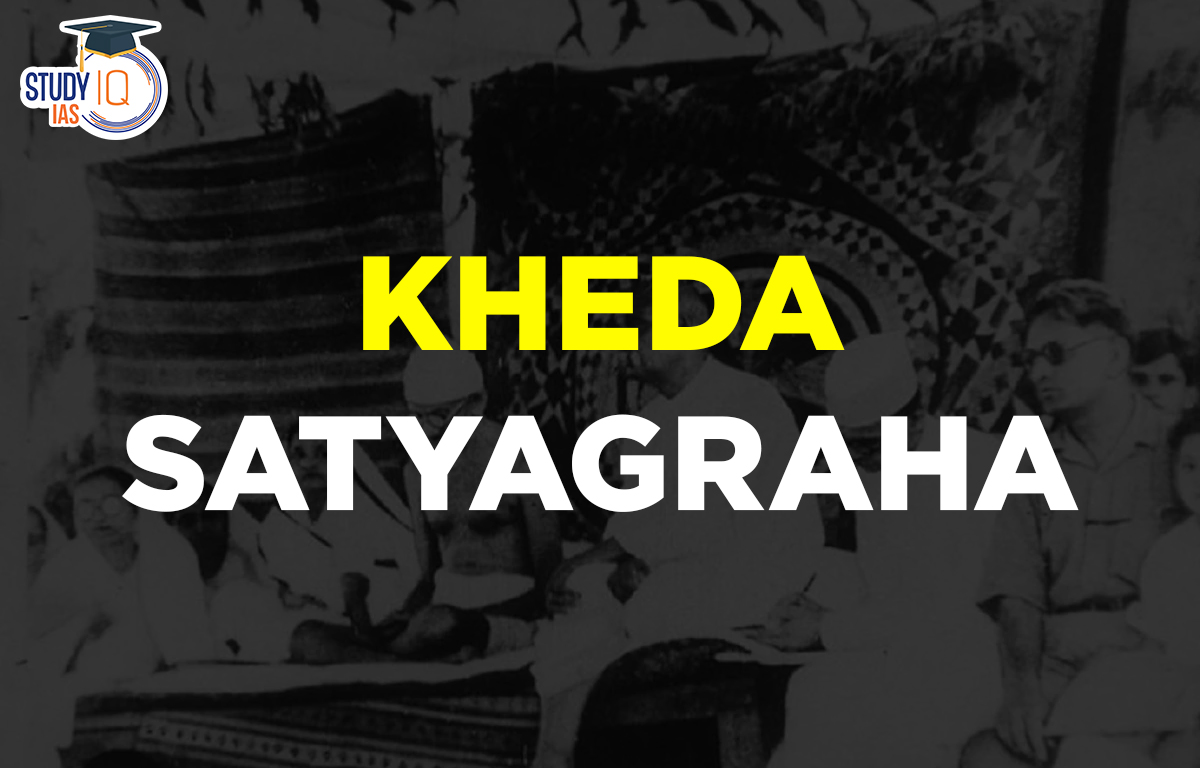Table of Contents
Kheda Satyagraha
Kheda Satyagraha was started by Mahatma Gandhi. Mahatma Gandhi is credited with starting the first Non-Cooperation Movement with the Kheda Satyagraha in 1918. The peasant-Patidar community of Kheda, who refused to accept a 23 percent tax increase imposed on them despite a devastating crop failure and an outbreak of plague and cholera, served as the focal point of this satyagraha. Read this article to get more about Kheda Satyagraha for UPSC.
Gandhiji’s team members, including Indulal Yagnik, Shankarlal Banker, and Mahadev Desai, among others, travelled throughout the countryside promoting awareness about farmers’ rights with the assistance of stalwarts like Sardar Vallabhbhai Patel. The characteristics of Kheda Satyagraha will be covered in this article in order to aid with UPSC test preparation.
Kheda Satyagraha History
The crops and land in Kheda were inspected by the authorities. The tax was raised by up to 23% based on land statistics. This didn’t sit well with the peasants. The peasantry experienced frequent hardships like as famines, resource shortages, untouchability, intoxication, and persecution by the British.
One of the main reasons for Kheda Satyagraha is famine. There were severe crop failures as a result of the famine, which afflicted the peasantry. On the other side, the government insisted on collecting all of the land taxes due and refused to tolerate crop loss. However, the peasantry performed its own research and consistently asserted that the government was wrong to demand the full amount of the land tax.
The highest administrative officials in the province were telegraphed and petitioned by the Gujarat Peasant’s Sabha to postpone the 1919 income assessment. Officials, however, disregarded the public’s call for tax relief. Gandhi encouraged the Kheda peasants to participate in satyagraha after the authorities rejected their requests for the non-payment of land tax. A brief note on Kheda Satyagraha in Indian history is created by the motivations behind this protest.
Kheda Satyagraha Movement Features
The campaign in Gujarat was primarily led by Mahatma Gandhi on an intellectual level. In addition to other local attorneys and advocates including Indulal Yagnik, Shankarlal Banker, and Mahadev Desai, he received assistance from the newly established Satyagraha Sardar Vallabhbhai Patel. They made a tour of the countryside, organising the residents and giving them political guidance and leadership.
The organisers of the uprising attracted a large number of furious Gujaratis from Ahmedabad and Vadodara, but Gandhi and Patel discouraged the participation of Indians from other regions, preferring to keep the conflict exclusively Gujarati. The Kheda peasants submitted a declaration during the famine asking that the levy for this year be removed. The declaration was rejected by the Bombay administration. They warned the peasants that if they did not pay, their farms and properties would be confiscated, and many would be put in prison.
While the police seized all real estate and agricultural land, the government’s inspectors and collectors sent out goons to steal property and livestock. The farmers did not use aggression against the officers or attempt to elude arrest. Instead, they gave the Gujarat Sabha money and jewels, which helped to officially organize the protest.
Kheda Satyagraha Effect
The administration made an effort to help the parties come to an amicable agreement. All confiscated property would be restored, the rate rise would be scaled back, and the current and following year’s taxes would be deferred. A new awakening came about as a result of giving in to the peasants’ demand. They learned from the conflict that achieving complete independence for their nation would be necessary before they could be free from injustice and exploitation.
The Kheda Satyagraha is regarded as one of India’s greatest triumphs. This movement stands out because its members refrain from acting violently throughout the duration of the campaign. Nevertheless, they are delivered in a lovely and modest way. The challenging Kheda Satyagraha campaign laid the foundation for Indian peasants’ patriotism, boosting national pride.
The Kheda Satyagraha’s accomplishment stunned the nation and gave people in India hope for their independence. Kheda Satyagraha motivated Indians to fight for the freedom of their nation after many battles.
Kheda Satyagraha UPSC
Kheda Satyagraha began on March 11, 1918; it took place in Kheda, Gujarat; and the reason for it was that the peasant-Patidar hamlet of Kheda was forced to accept a 23% tax increase despite a devastating crop failure and outbreaks of plague and cholera. Kheda Satyagraha is also referred to as the first Non-Cooperation Movement led by Mahatma Gandhi. This article has complete detail about the about the Kheda Satyagraha for UPSC/IAS Examination.
Kheda Satyagraha FAQs
Q. What was the aim of Kheda Satyagraha?
Ans. Gandhi directed Sardar Vallabhbhai Patel to lead the farmers in a demonstration against tax collecting after the famine. The initiative is supported by residents of the district of all castes and races.
Q. When did Kheda Satyagraha started?
Ans. On March 11, 1918, barely four days after the massive mill strike in Ahmedabad, the Kheda Satyagraha got underway.
Q. Why Kheda Satyagraha is called non cooperation movement?
Ans. The Kheda Village in the Bardoli District, where the peasants were led by Gandi Ji, became the first successful full example of non-cooperation when they refused to pay 23% higher rents. The campaign demanded that enhanced rents not be paid, that just rent be paid, and that begaar and hali not be performed.
Q. Why did Gandhiji went to Kheda?
Ans. Gandhiji led the agitation in 1917 in Gujarat’s Kheda area, calling for a relaxation of the revenue tax because the farmers there were suffering from poverty due to the plague outbreak and crop failure.
Q. What was the main demand of Kheda Satyagraha?
Ans. A decrease in income payments was the main demand of the Kheda peasants.


 Birsa Munda Birth Anniversary 2025: Life...
Birsa Munda Birth Anniversary 2025: Life...
 Military Innovations of Afghans and Turk...
Military Innovations of Afghans and Turk...
 Self-Respect Movement, History, Objectiv...
Self-Respect Movement, History, Objectiv...

























